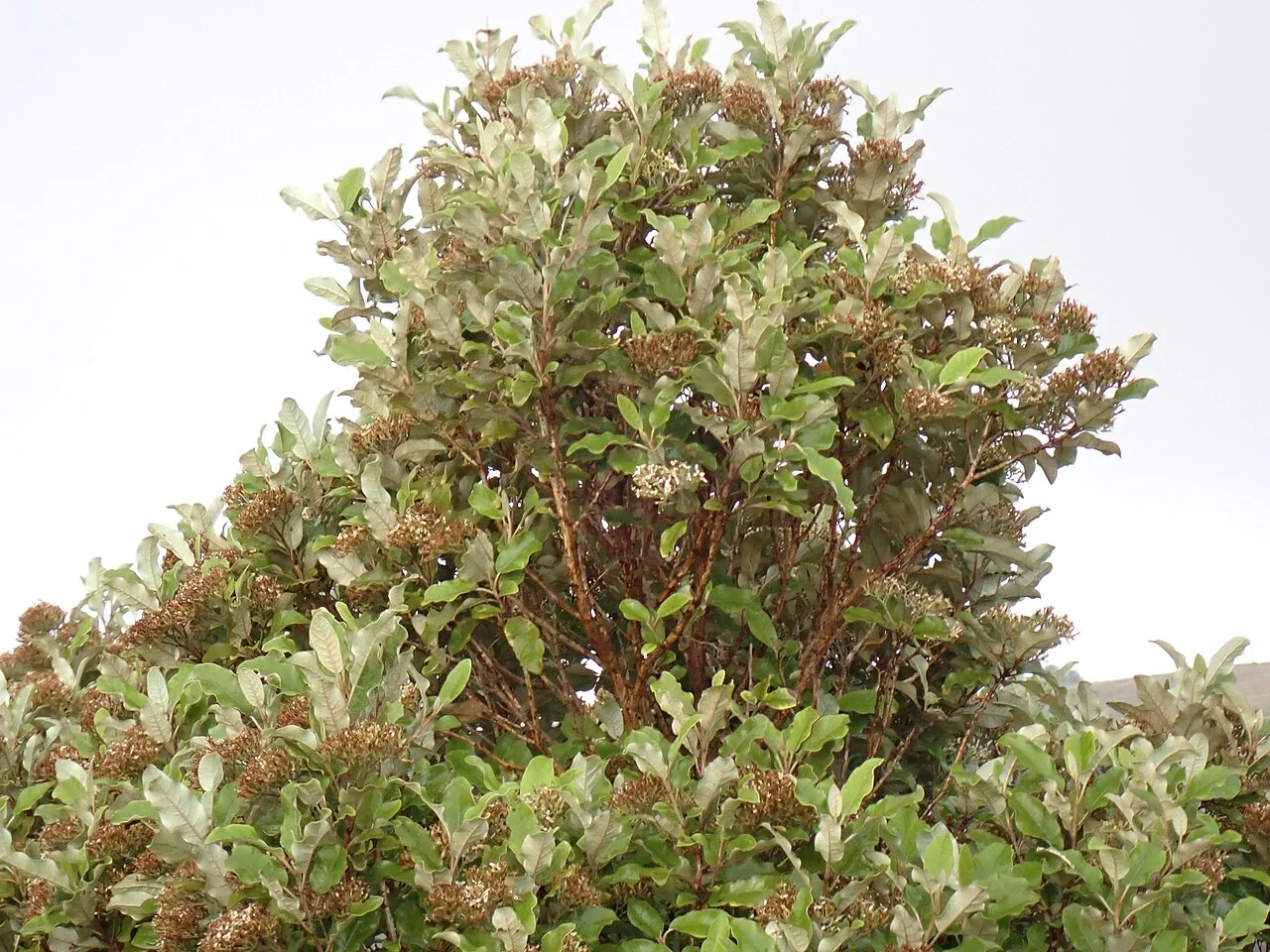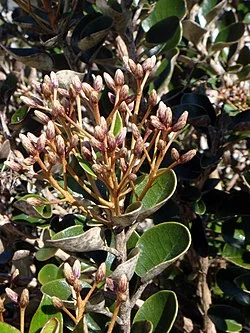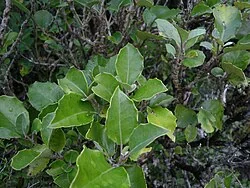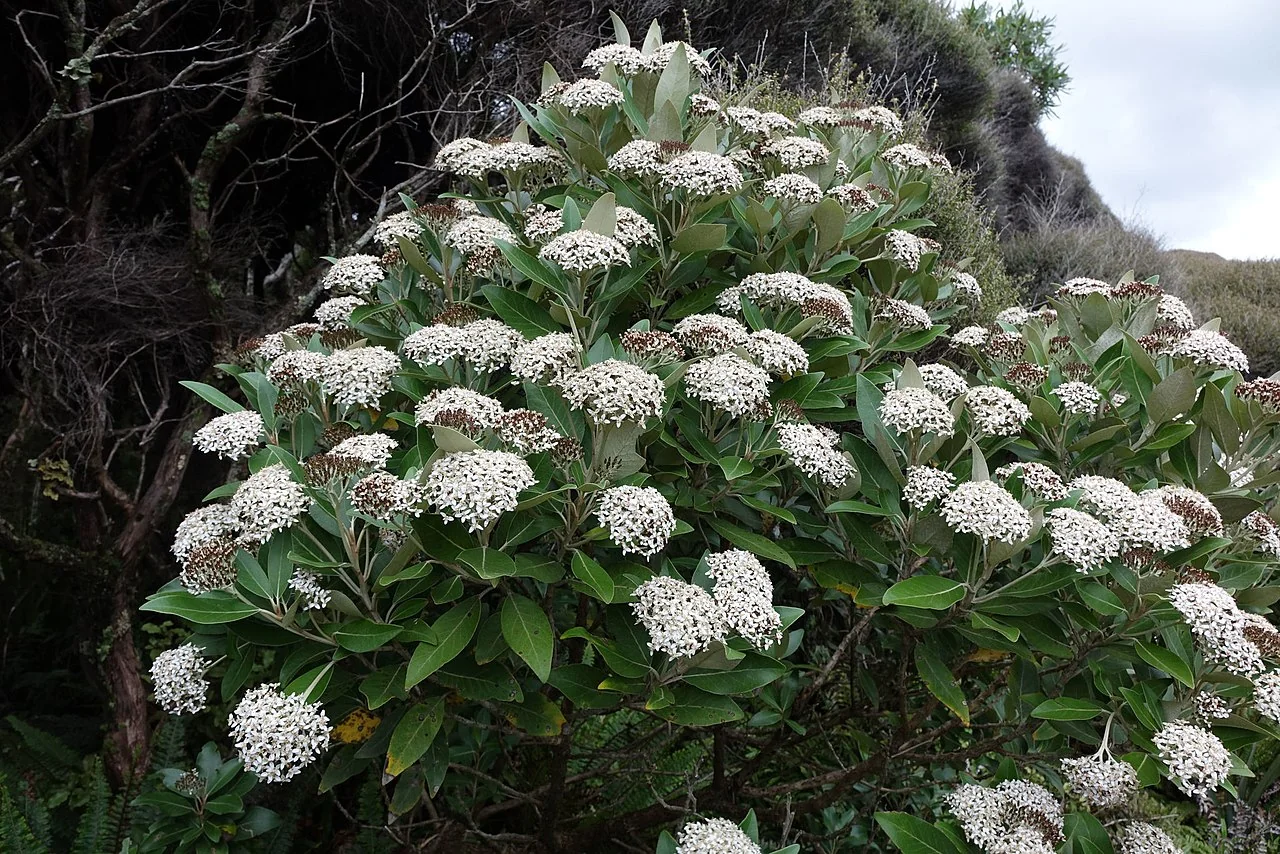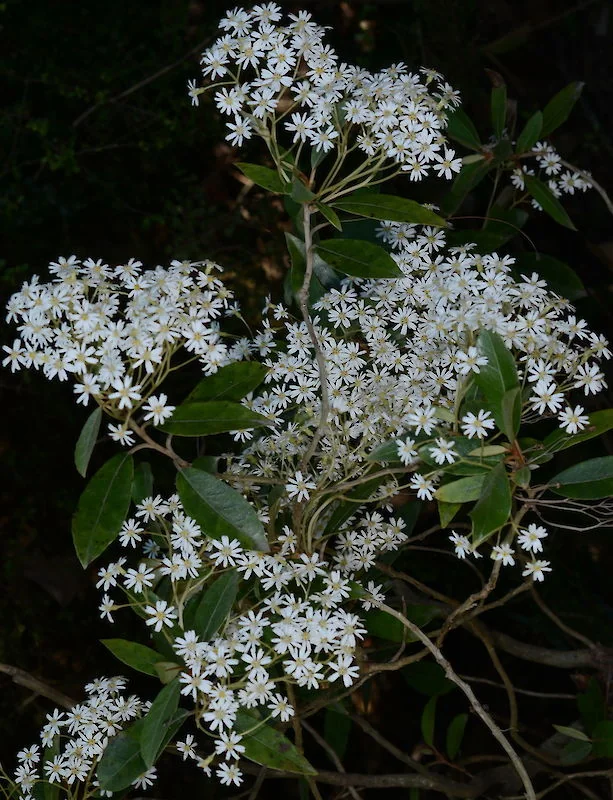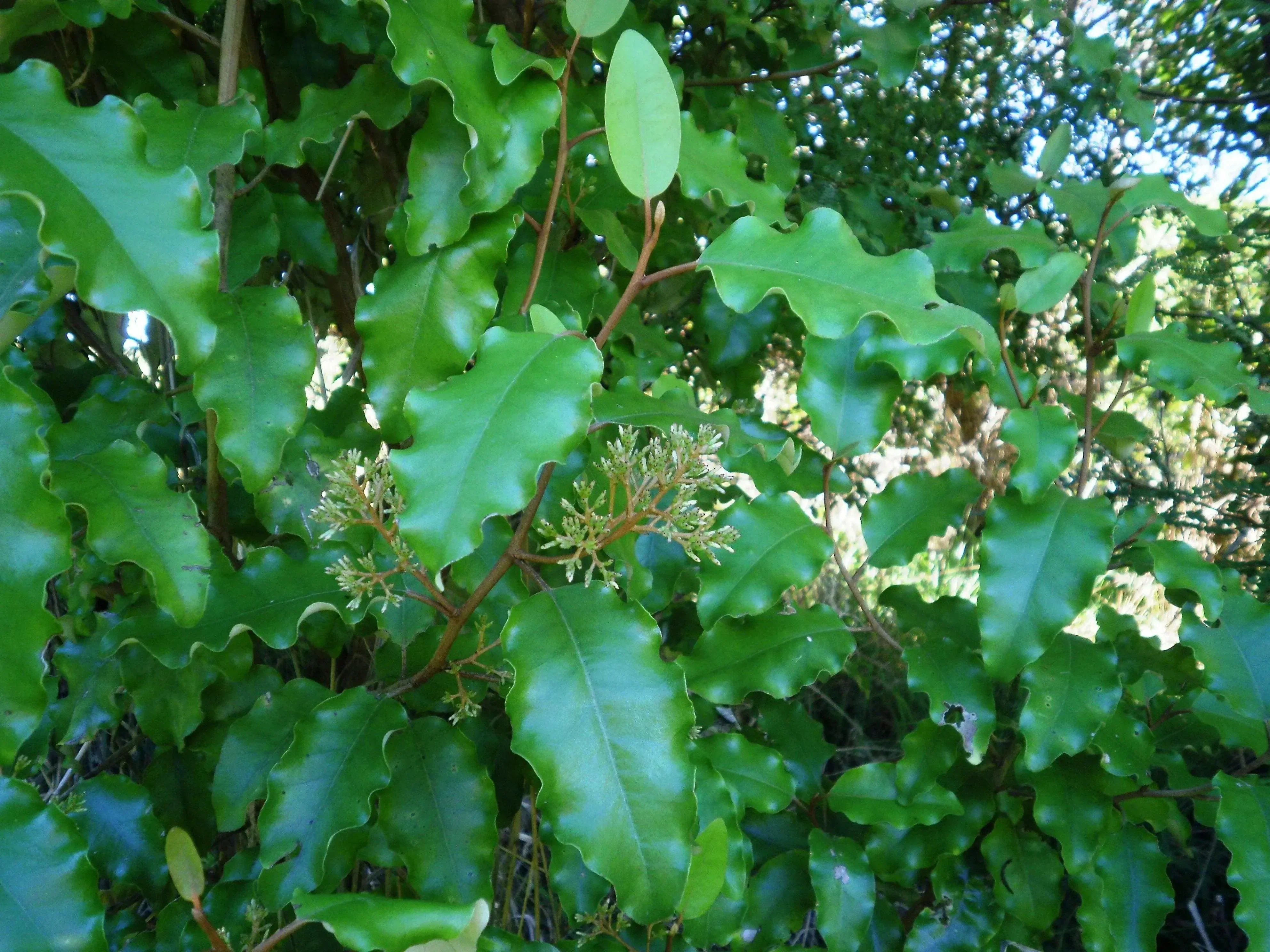
Hakeke
Olearia ilicifolia
Mountain Holly (scientific name: Olearia ilicifolia ) Mountain Holly is a native tree daisy that produces masses of small white or cream flowers. Like other Olearia species, it's valued for its hardy nature and ability to provide shelter and nectar for native wildlife. Explore more in the native plants index .

Plant Description
Botanical Features
Hakeke ( Olearia ilicifolia ), also known as mountain holly or New Zealand holly, is an evergreen shrub or small tree endemic to New Zealand. It typically grows to 3-6 meters tall and 3 meters wide, often forming a domed canopy. Its leaves are dark green to grayish-green, leathery, 5-12 cm long by 1-2 cm wide, with distinctive undulating and sharply serrated or spiny margins. The upper surface is mostly glabrous, while the underside is covered in a fine, whitish felt. The trunk and lower branches are covered in orange-grey bark that often peels in long strips. Numerous white daisy-like flowers with yellow centers are borne in dense, branched clusters (corymbs) towards the branchlet tips, typically in June. The flowers have a strong, musky perfume. These develop into small, wind-borne brown seeds, each topped with a fluffy, yellowish pappus.
Quick Facts
Overview
| Scientific Name | Olearia Ilicifolia |
|---|---|
| Height | 2-6 m |
| Spread | 2-4 m |
| Water Needs | Low to moderate |
| Light | Full sun to partial shade |
| Frost Tolerance | Moderate to good |
| Salt Tolerance | Moderate |
| Growth Rate | Moderate |
| Lifespan | Long-lived |
Climate Best Suited to
Regional climate suitability across major New Zealand cities.
Regional Suitability
| Whangārei | Ideal |
| Auckland | Ideal |
| Hamilton | Suitable |
| Rotorua | Suitable |
| Tauranga | Ideal |
| Gisborne | Ideal |
| New Plymouth | Ideal |
| Whanganui | Ideal |
| Palmerston North | Suitable |
| Napier | Ideal |
| Wellington | Ideal |
| Nelson | Ideal |
| Christchurch | Suitable |
| Dunedin | Suitable |
| Invercargill | Suitable |
| City | Climate Suitability |
|---|
Natural Habitat
Hakeke is endemic to New Zealand, found in lowland to sub-alpine forest and scrub environments, extending from sea level up to 1,200 meters in altitude. Its range covers the North, South, and Stewart Islands, typically southwards from latitude 38°S. It thrives in shrublands, river flats, and valley heads, and is also prominent on ridgelines in what are sometimes called 'cloud' or 'goblin' forests. It is a common riparian species in the montane river systems of the western South Island.
Conservation
Plant Conservation
Olearia ilicifolia , also known as hakeke, mountain holly, Māori-holly, or New Zealand holly, is a shrub or small tree endemic to New Zealand. It is found across the North, South, and Stewart Islands. This species thrives in a variety of habitats, ranging from lowland to subalpine regions. It can be found in shrublands, river flats, valley heads, and on ridgelines in "cloud" and "goblin" forests. It is also a common riparian species in the montane river systems of the western South Island. Regarding its conservation status, Olearia ilicifolia is currently classified as "Not Threatened" according to the 2023 assessment by the New Zealand Plant Conservation Network. This status has been consistent in previous assessments from 2004, 2009, 2012, and 2017. The plant is considered hardy and resilient, capable of tolerating a wide range of conditions, including exposed and upland sites. It is also resistant to maritime exposure and can withstand severe pruning. Olearia ilicifolia can be easily propagated from semi-hardwood cuttings and fresh seeds, preferring cool climates and well-drained, moist, humus-enriched soil. Its hardiness and adaptability make it suitable for native revegetation projects and landscaping, where it can serve as a screening or shelter plant and provide resources for pollinators.
Growing Requirements
Soil Requirements
Holly-leaved tree daisy prefers free-draining soils with organic matter; tolerates a wide pH range.
Light Requirements
Full sun to partial shade; tough and frost hardy.
Water Requirements
Low-moderate; water regularly in first summers.
Planting Guide
1. Site Selection:
- Sun Exposure: Olearia ilicifolia thrives best in full sun or partial shade.
- Soil: It prefers well-drained, moderately fertile soil. It can succeed in chalky soil but prefers light loam or peaty soil. It is not tolerant of heavy soils.
- Climate: This plant naturally thrives in cooler regions and is tolerant of a wide range of conditions, including exposed and upland sites. It is very tolerant of maritime exposure. It is hardy to UK zone 8, tolerating temperatures down to about -15°C. It dislikes hot or humid conditions.
2. Planting:
- Timing: The best time to plant Olearia ilicifolia is in autumn or spring to encourage strong root establishment.
- Spacing: When planting in groups, space plants 2-3 meters apart to allow for their mature spread.
- Mulching: Mulching around the base of the plant helps conserve soil moisture and suppress weeds.
Ecological Role
Environmental Benefits
Mountain holly ( Olearia ilicifolia ) occupies cool montane forest and scrub, where its rigid, holly‑like leaves tolerate wind and snow. Summer blossoms attract a range of native pollinating insects; dense foliage provides shelter and edge structure for birds and understorey species across steep, erosion‑prone terrain.
- Pollination: Daisy inflorescences offer nectar and pollen to flies and bees.
- Edge shelter: Forms wind‑tolerant thickets along forest margins and ridges.
- Slope stability: Roots help bind shallow soils on cool mountain slopes.
Uses and Significance
Landscape Applications
Olearia ilicifolia excels as a hedge or screen plant, with its distinctive spiny-margined leaves providing excellent browsing deterrent properties. This beautiful small tree or shrub is well-suited to rockery margins and makes an effective windbreak in coastal areas. Its tolerance for coastal conditions and natural domed canopy form make it ideal for screening purposes in challenging New Zealand environments.
The defensive holly-like foliage effectively deters browsing animals, while the numerous white daisy flowers borne in dense clusters provide essential pollinator support. This endemic New Zealand species contributes to native biodiversity and offers wildlife habitat from lowland to subalpine environments, supporting both insects and birds throughout its natural range.
Cultural Importance
Cultural Significance
Hakeke in Cultural Landscapes
Known as Hakeke in many areas, Olearia ilicifolia forms prickly, holly‑like foliage that shelters understorey birds and seedlings along forest margins. While documented rongoā for this species is sparse, related akeake woods were prized for toughness. Modern projects use eco‑sourced Hakeke for wind‑filters on ridgelines and as a defensive boundary in restoration māra, reflecting kaitiakitanga values of shelter, resilience and biodiversity support.
Olearia ilicifolia , also known as Hakeke or Mountain Holly, holds cultural significance in Aotearoa (New Zealand). Olearia species, including Hakeke, were valued by Māori for their practical uses. The strong, dense wood of larger Olearia species, such as akeake, was utilized for crafting tool handles, weapons, and construction materials. The name "akeake" itself reflects the wood's hardness and durability, making it highly prized for items requiring strength, like fence posts and various implements. Some Olearia species also provided traditional medicines, with specific applications varying among different iwi (tribes) and regions. Beyond its historical uses, Hakeke is valued in contemporary restoration efforts and gardens for the ecological services it provides.
Landscaping Ideas
Hakeke ( Olearia ilicifolia ), also known as Mountain Holly, is an exceptionally versatile native shrub that brings year-round structure and distinctive character to New Zealand landscaping projects. Its unique serrated, holly-like leaves and hardy constitution make it particularly valuable for both functional and ornamental applications, especially in cooler climates where it thrives naturally from lowland to subalpine environments.
Windbreak and Shelter Plantings
- Coastal windbreaks: Outstanding performance in coastal areas where its natural salt tolerance and wind resistance create effective protective barriers. Plant in rows 1-2 meters apart for dense, persistent windbreak establishment.
- Rural shelter belts: Excellent component of mixed native shelter belts, providing reliable protection for more tender species while requiring minimal maintenance once established.
- Garden wind protection: Strategic placement around outdoor living areas and vegetable gardens creates comfortable microclimates while maintaining attractive year-round appearance.
- Slope stabilization: Root systems help stabilize banks and slopes while the dense foliage reduces wind erosion, making it valuable for practical landscape stabilization projects.
Formal and Structured Landscaping
- Hedge formation: Responds exceptionally well to pruning and shaping, creating dense, formal hedges that maintain neat boundaries. Can be hard pruned and regenerates well from low cuts.
- Topiary potential: Dense growth habit and tolerance of heavy pruning make it suitable for topiary work and shaped features in formal garden designs.
- Foundation plantings: Provides excellent structural backbone for foundation beds with consistent year-round appearance and manageable size through pruning.
- Screening applications: Dense foliage creates effective privacy screens for property boundaries, utility areas, or unsightly views while adding native character.
Native Garden Integration
- Alpine and rock gardens: Perfectly suited to rockery margins and alpine-style gardens where its natural mountain habitat preferences create authentic native landscapes.
- Mixed native borders: Excellent backdrop plant for mixed native plantings, providing structure and contrast with its distinctive serrated foliage and white flower clusters.
- Succession planting: Pioneer species for establishing native plant communities, creating shelter and soil improvement for more sensitive native species to follow.
- Wildlife habitat gardens: Dense branching provides excellent nesting sites for small birds while flowers support native pollinators, particularly valuable in subalpine and montane garden themes.
Specimen and Feature Plantings
- Architectural specimens: Individual plants create striking focal points with distinctive holly-like foliage and compact growth habit, particularly effective against contrasting backgrounds.
- Seasonal interest displays: Spring and summer flowering provides masses of fragrant white daisy blooms, followed by interesting seed heads that extend ornamental value.
- Texture and contrast: Unique serrated leaf edges and grey-green coloration provide excellent textural contrast in mixed plantings, particularly when paired with broad-leaved or fine-textured plants.
- Container cultivation: Adapts well to large containers for patios, terraces, and courtyards where controlled positioning enhances design flexibility and seasonal mobility.
Cool Climate Specialization
- Montane garden themes: Essential component of authentic montane and subalpine garden designs, bringing natural mountain flora characteristics to cultivated landscapes.
- Frost-resistant landscaping: Outstanding cold tolerance makes it reliable for areas prone to heavy frosts where many other evergreen shrubs struggle to survive.
- High-elevation gardens: Naturally adapted to high-elevation conditions, making it perfect for mountain properties and hill country landscapes where extreme weather is common.
- Cool season performance: Maintains excellent appearance through winter months when many other plants look tired, providing vital structure during dormant garden periods.
Practical Landscape Benefits
- Low maintenance requirements: Once established, requires minimal ongoing care beyond occasional pruning, making it ideal for low-maintenance landscapes and public spaces.
- Pollution tolerance: Adapts well to urban conditions and roadside plantings where air quality may be compromised, providing reliable performance in challenging environments.
- Deer resistance: Spiny leaf edges and strong scent provide natural deterrent against browsing animals, reducing damage in rural and semi-rural landscapes.
- Fire retardant properties: Dense, moisture-retaining foliage and green growth habit contribute to fire-resistant landscape design in areas prone to wildfire risk.
Design Combinations and Companions
- Complementary natives: Pairs excellently with other montane natives like Hebe species, Dracophyllum, and alpine Coprosma varieties for authentic ecosystem recreation.
- Seasonal layering: Provides evergreen backbone for gardens featuring deciduous natives or seasonal bulb displays, maintaining structure throughout changing seasons.
- Colour harmony: Grey-green foliage creates neutral backdrop that enhances colourful flowering companions without competing for visual attention.
- Scale relationships: Intermediate size makes it perfect bridge plant between groundcovers and larger trees, creating natural transition zones in layered plantings.
Seasonal Care Calendar
Spring
Plant/clip lightly.
Summer
Water new plants in dry spells; deadhead lightly if desired.
Autumn
Shape after flowering.
Winter
Hardy; ensure drainage.
Pruning and Maintenance
Techniques and Timing
Mountain holly clips beautifully and responds well to regular pruning for hedge maintenance or shaping. The species tolerates moderate pruning throughout the growing season but avoid severe cutting back to bare wood as recovery can be slow. Light clipping after flowering helps maintain the natural domed canopy form while encouraging dense growth. Regular tip pruning enhances the plant's natural screening ability and promotes bushier habit for hedging applications.
How to Grow Hakeke
Hakeke, also known as Mountain Holly, is a hardy native tree daisy with distinctive spiny leaves and musky white flowers. This robust shrub or small tree is naturally found in cool temperate and montane regions of New Zealand, where it has adapted to challenging conditions including wind and frost. Hakeke is particularly valued in cultivation for its tough, evergreen foliage, its ability to form dense hedges, and its late-season flowering displays that provide crucial nectar resources. Understanding its propagation methods is key to successfully growing this delightful species.
From Cuttings
Semi-hardwood cuttings are a reliable and efficient method for propagating Hakeke, ensuring that new plants retain the exact characteristics of the parent. Take 8-12 cm cuttings from healthy, non-flowering shoots in late summer or early autumn. Dip in rooting hormone and place in a well-draining propagation mix. Maintain consistent humidity with misting or enclosed propagation chambers. Successful rooting typically occurs within 6-8 weeks under warm, humid conditions. Once rooted, the new plants can be potted on and grown in a sheltered environment until they are ready for planting.
From Seed
Propagating Hakeke from seed is a viable method, though it requires fresh seeds and careful attention to conditions. Collect fine seed from dried flower heads in late autumn, storing in cool, dry conditions until sowing in spring. Surface-sow without covering on a free-draining seed mix, as seed requires exposure to light for optimal germination. Maintain consistent moisture without waterlogging, with germination typically occurring within 2-4 weeks under suitable conditions of 18-20°C. Seedlings establish quickly and can be transplanted when large enough to handle safely. This method is crucial for maintaining genetic diversity and for large-scale restoration projects.
Pests and Diseases
Hakeke ( Olearia ilicifolia ) is generally a robust and hardy native shrub that experiences relatively few serious pest or disease problems when grown in appropriate conditions. Its natural adaptation to challenging mountain and coastal environments contributes to its overall resilience and resistance to many common garden problems.
General Disease Resistance
- Natural hardy constitution: Like many Olearia species, mountain holly demonstrates excellent natural resistance to most pests and diseases, making it a low-maintenance choice for landscape applications.
- Environmental adaptability: Its tolerance of wind, salt, and temperature variations reduces stress-related susceptibility to pest and disease problems commonly affecting less hardy plants.
- Honey fungus resistance: Generally resistant to honey fungus ( Armillaria species), though occasional susceptibility may occur in poorly drained or stressed conditions.
Occasional Pest Issues
- Aphids: May occasionally attract aphids, particularly during spring growth periods when soft new foliage provides attractive feeding sites. Monitor regularly and treat with insecticidal soap or introduce beneficial insects like ladybugs for natural control.
- Scale insects: Soft or hard scale insects may occasionally affect mountain holly, appearing as small bumps on stems and leaves. Treat during active crawler stages with horticultural oil or systemic treatments if infestations become serious.
- Leaf miners: Rarely affected by leaf mining insects, but if present, remove affected foliage and monitor for spread. Most damage is cosmetic rather than threatening to plant health.
Environmental Stress Prevention
- Drainage requirements: The most critical factor for preventing disease problems is ensuring excellent drainage. Poor drainage leads to root rot and general decline, making plants susceptible to secondary problems.
- Air circulation: Adequate spacing between plants promotes good air circulation, reducing humidity levels that can encourage fungal problems and improving overall plant health.
- Moisture management: While drought-tolerant once established, avoid allowing plants to dry out completely during establishment. Conversely, avoid overwatering which can lead to root problems.
- Site selection: Plant in sunny positions with good drainage and air movement to minimize stress factors that predispose plants to pest and disease problems.
Cultural Disease Prevention
- Soil preparation: Ensure well-draining, fertile soil enriched with organic matter. Heavy clay soils should be amended to improve drainage before planting.
- Pruning hygiene: Use clean, sharp tools for any pruning work to prevent introduction of diseases. Remove dead, diseased, or damaged wood promptly to maintain plant health.
- Seasonal monitoring: Regular inspection during growing seasons allows early detection and treatment of any problems before they become serious threats to plant health.
- Stress reduction: Maintain consistent growing conditions and avoid practices that stress plants, such as overfertilisation, incorrect watering, or mechanical damage.
Browsing and Physical Damage
- Deer resistance: The spiny leaf edges and strong scent provide natural deterrent against browsing by deer and other mammals, reducing physical damage in rural landscapes.
- Wind damage: Excellent wind tolerance means that physical damage from storms and strong winds is rarely a problem, even in exposed coastal locations.
- Frost protection: Hardy constitution means frost damage is uncommon, but young plants may benefit from protection during their first winter in very exposed sites.
Integrated Management Approach
- Preventive care: Focus on providing optimal growing conditions rather than reactive treatments. Healthy plants naturally resist most pest and disease problems.
- Organic controls: When intervention is needed, use organic methods such as insecticidal soaps, neem oil, and beneficial insect release to maintain environmental balance.
- Beneficial habitat: The flowers naturally attract beneficial insects that help control pest populations, so avoid broad-spectrum pesticides that harm these natural allies.
- Minimal intervention: This species typically requires very little pest and disease management when grown in suitable conditions, making it ideal for low-maintenance landscapes.
Coastal Considerations
- Salt tolerance: Excellent tolerance of salt spray and coastal conditions means that salt-related stress and associated problems are rarely encountered in seaside gardens.
- Wind resistance: Natural adaptation to windy conditions reduces physical damage and stress that can predispose plants to pest and disease problems.
- Marine environment adaptation: Thrives in coastal conditions where many other plants struggle, demonstrating exceptional resilience to challenging environmental factors.
Regular monitoring combined with appropriate cultural practices will prevent most potential problems and maintain healthy, vigorous mountain holly plants throughout their lifespan.
Bonus Tip
Expert Growing Advice
Mountain holly ( Olearia ilicifolia ) has spiny, undulating leaves that make a great shelter in mountain gardens. Pair with wind-filtering shrubs rather than solid fences - filtered airflow reduces leaf scorch and supports the musky summer bloom flush.
